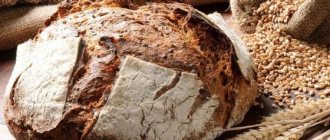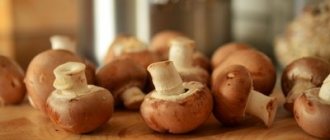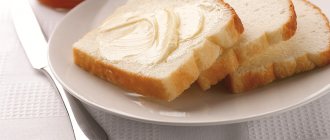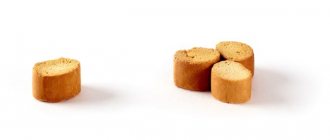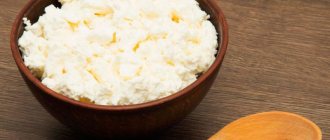What should people on a diet do who cannot do without bread? An alternative to white rolls made from high-grade flour can be Borodino black bread. Although this bread can hardly be called dietary in terms of calorie content, due to its beneficial qualities this product will help you in the difficult task of losing weight.
Of course, this does not mean that it is possible to eat a lot of Borodino bread and still be on a diet, but if you allow yourself a couple of pieces, it will even be beneficial.
Compound
Rumors are growing around Borodino bread that it is, in principle, dietary, because it contains rye flour. It is believed that it is due to this that the calorie content of the product is reduced. However, this stereotype is dispelled when information is received that this flour is only 15% in the recipe.
It is also surprising that the calorie content of the product is not much less than that of others: 207 kcal per 100 grams. To make it clear, the calorie content of white buns made from wheat flour is about 259 kcal per 100 grams. Agree, the difference is really small.
The question arises: why is this bread so popular among nutritionists? After all, it is really recommended to consume it in small quantities during a diet.
Firstly, the recipe for Borodino bread includes wheat flour, not the first, but the second grade. This can already be noted as a plus. After all, the most harmful to the body is flour of the first grade. It has a high percentage of gluten. But second-grade flour contains much more bran, which can stimulate the stomach and intestines in our body.
Secondly, this product contains healthy seeds. These are coriander and cumin, which are sprinkled on the top. In addition, the composition is rich in useful microelements, there is calcium, phosphorus, iron, potassium, magnesium, sodium. Vitamin compounds of group PP and B are also present there.
Rye bread. Product varieties
Not all rye bread is created equal. Back in the 17th century, 26 varieties of this product were known. Depending on the flour composition, it can be pure rye, rye-wheat and wheat-rye. By the way, bread made from a mixture of rye and wheat flour is known as gray. It is lighter than pure rye, but much darker than wheat. The gray version of bread is a kind of “golden mean”, which advantageously combines the advantages of two types of product.
According to production technology, rye baked goods can be unleavened, yeast-based or leavened. The first option involves kneading the dough without fermentation processes. Most commercially produced rye bread is made using yeast. But this option is considered the least useful. The kvass loaf is kneaded using a special sourdough starter.
In addition, baking can be simple or custard. In the second case, in addition to traditional ingredients, sugar, rye malt, molasses and spices are added to the dough. This bread is called custard for a reason. Before the main kneading, part of the flour and malt are brewed using boiling water. By the way, such loaves stay fresh longer.
The most famous rye custard bread is Borodinsky. The recipe for this sweet and spicy product was invented in the 19th century. In addition to rye flour, second-grade wheat flour, red rye malt, sourdough, salt, molasses, sugar, coriander, anise and cumin are used for its preparation.
Darnitsky bread is another equally popular variety of rye product. This recipe was invented in 1933 at Leningrad Bread. It is made from peeled rye flour, first grade wheat flour, liquid rye sourdough, salt and water. True, today most manufacturers replace traditional sourdough with compressed yeast.
Some housewives bake black bread at home. The complexity of the recipe lies in the long preparation of the sourdough. Before you start baking, you need to mix kefir, water and a little flour and leave the mixture for 7-10 days to ferment. During this time, you should regularly “feed” the starter by adding a little kefir and flour. But the finished base can be stored in the refrigerator for quite a long time.
Who is extremely beneficial to eat this bread?
Although we have dispelled the myth that this product is low in calories, it can be added to the diet of people who are struggling with excess weight. You can eat 100 grams per day, this will be approximately 2-3 pieces. By the way, reducing the calorie content by 100 grams of any baked product is very simple: dry it until it becomes toast in the oven or toaster.
If you eat this bread in small portions, about 100 grams per day, your intestines will be stimulated, which in turn will help the body get rid of feces more easily.
Just keep in mind that Borodino bread will not harm you on a diet, only if you give up the idea of making a sandwich out of it. That is, no butter, sausages or cheese, this will increase the calorie content of the product per 100 grams.
It is a must for those who care about their beauty to add this baked product to their diet. The vitamin groups and microelements present in the composition will help maintain hair and nails in good condition, and improve skin health.
Due to the fact that this type of baking helps intestinal motility, it is necessary for people with problems of constipation, gout and hypertension.
This product also helps cleanse the body of toxins in the intestines, excess salts, toxins, and cholesterol.
How to choose bread in a store
Experts advise always reading the label and choosing bread that contains: rye flour (whole grain or coarsely ground), water, natural rye, yogurt or kefir starter, salt and vegetable oil. It’s good if bran, grains, seeds, nuts, and dried fruits are added to the product. But the presence of sugar, yeast, margarine, and starch in bread is undesirable.
When planning to buy packaged bread, you should first check the production date and expiration date of the product. Good quality baked goods tend to harden quickly. If the loaf sits for more than a day and remains soft, it means there are a lot of harmful additives in it. Fresh bread should not crumble: the presence of a large number of crumbs in the package, as a rule, indicates that the production technology is broken. For the same reason, when you press on low-quality bread, a dent will remain on the loaf, meaning the product will not restore its original shape. Uneven coloring of the crust and crumb is another indicator of bad bread: heat was not distributed evenly during baking.
Often, bread from supermarkets quickly begins to crumble and mold. Marina Kostyuchenko believes that this is due to the low quality of grain and flour: there is now not enough wheat suitable for producing high-quality flour, so the taste of bread, its aroma and nutritional value have deteriorated in recent years.
Who should not use this product?
Even if, by all criteria, it is necessary and beneficial for you to eat dark rolls, do not harm yourself and do not abuse it. Do not eat more than 200 grams of this product per day. In addition, despite all the beneficial qualities of Borodino bread, there are people who are not recommended to use it.
Namely:
- People who have been diagnosed with diabetes should not eat this type of baking a lot. They need to stick to the norm and consume up to 100 grams just a couple of days a week.
- Also, those who have increased acidity of gastric juice should be careful with this product.
- A contraindication is also the presence of enterocolitis and celiac disease in a person.
Remember that any product is good in moderation. No matter how many nutrients there are in 100 grams, this is still not an indication to eat this bread in loaves.
siladiet.ru
Borodino bread during pregnancy and breastfeeding
According to nutritionists, this is the best type of baking for expectant mothers: the composition will not harm the baby, but will give the pregnant woman energy. The optimal amount per day is three slices (250 g).
Despite its beneficial properties, using this product during breastfeeding has some nuances. Sometimes manufacturers change the traditional recipe by including additional ingredients. This could be yeast or a large number of spices and herbs. It is better for a nursing mother to refuse such bread so as not to harm the baby. It can cause colic and indigestion in the baby.
We recommend reading: What are the benefits of yeast-free bread and how to bake it
Comment! When purchasing a loaf, it is recommended to carefully study its composition. If there is nothing extra in the baking, bread can be consumed in limited quantities while breastfeeding.
Types of bread with a “dietary bias”
What kind of bread can you eat while losing weight? The most common bread product is made from the following types of flour:
- white;
- rye;
- containing bran;
- buckwheat
Whole grain baked goods are the healthiest.
It is preferable to buy white bread made from wholemeal flour, the so-called whole grain. Nutrients are retained in large quantities.
The most useful are breads with various additives such as flax seeds, pumpkin and sunflower seeds, oats or millet grains.
By the way, it was on the use of “coarsely ground” bread that Olga Raz-Kessner, director of the nutrition and diet department of the Tel Aviv Ichilov Hospital, based her bread diet, devoting an entire book to it, which became a bestseller, “Bread for Life. Carbohydrate program for weight loss" (Matar publishing house, 2001).
White and black bread differ little in calorie content and amount of carbohydrates. There is also such a thing as the glycemic index, which characterizes the ability of a food product to increase appetite, which can increase the frequency of meals. In this sense, rye bread has an advantage. And in terms of lower calorie content, black Borodinsky is the leader - there are 207 in 100 grams, while even bran has 216.
Bread products with bran are very suitable for dietary nutrition. They contain vitamins, valuable proteins, fiber, and nicotinic acid, which can prevent diseases of the gastrointestinal tract and the occurrence of atherosclerosis.
Bread made from buckwheat flour is a storehouse of a whole vitamin and mineral complex. Its usefulness and nutritional value are undeniable - the feeling of fullness does not leave a person on a diet for a long time.
How much bread do you need
If you are losing weight, nutritionists advise eating about 30–50 grams of whole grains in the morning. If your body weight is normal, it is recommended to eat no more than 175 grams (four to five pieces of bread) daily. Nutritionist Oleg Iryshkin notes that you can completely give up bread if your diet contains enough cereals (buckwheat, bulgur, pearl barley) and whole grain pasta.
The same bread is good for children as it is for adults. But the constant presence of fiber in a child’s diet is undesirable, as it can disrupt the functioning of the gastrointestinal tract: “coarse” bread is more difficult to digest. Margarita Koroleva advises starting to introduce your child to bread no earlier than one year. At the same time, give no more than 10 grams of the product per day. Every year the amount of bread can be increased.
What can you eat instead of bread?
Choose the right breads.
Some people think that bread is still a problematic product when losing weight. What to replace it with in this case? Nutritionists especially recommend rye bread.
However, such a product can cause problems in people whose stomach acidity is high. In this case, the rye-wheat option is suitable.
Crisps can be made from different types of flour, with different calorie content, so not all of them are dietary.
When choosing them, you need to pay attention to the composition indicated on the packaging. The main “production material” is wholemeal flour.
The extrusion method is used to prepare the bread. Of course, they look less appetizing than baked ones, but they retain a rich chemical composition, and therefore they are healthier. The impact of pressure and high temperature during this technological process ensures the decomposition of complex cellular components into simpler ones that can more easily release their energy. These breads are easier to digest.
And although this product is not much different from bread in terms of caloric content, the carbohydrates included in its composition belong to the “slow” category: the body absorbs them better, and the feeling of fullness remains longer. It is hardly possible to gain weight from bread, unless, of course, you eat them exclusively. How much should I eat? It is enough to eat no more than three pieces, and it is better in the first half of the day.
Biscuits are another product that can be used to replace bread during weight loss. They are made from different types of flour, including pea and bean flour, with the addition of water. This product can be stored for quite a long time without losing its beneficial properties.
When reducing weight, yeast-free types of baked goods such as those made with kvass, Armenian lavash, and matzo are preferable. This is the answer to the question whether yeast-free bread is possible on a diet. The high density of such bread facilitates digestion, does not harm the intestinal microflora, and the body absorbs it better.
The whole truth about yeast
Who are they? To be precise, these are single-celled fungi that live everywhere, including in ourselves. There are a lot of different conversations about them, from rumors to horror stories.
Among the most famous is the story of thermophilic yeast. There is talk that this is a biological weapon that was invented by geneticists; they do not die at high temperatures (and therefore when baking bread), reproduce well and cause great harm to the body.
Others say that this is all fiction and that there really is no killer yeast. So many people, so many opinions. This topic is actually a big one, and if you are interested in it, we can talk about it in another article - write your thoughts and wishes in the comments.
For my part, I am inclined to believe that thermophilic yeast is harmful to the human body.
Here, for example, is a video about what such yeast is:
And here is what the famous blogger and person I respect, Roman Milovanov, says on this topic. He tested many aspects of nutrition on himself.
We continue the conversation and are now looking for yeast-free bread.
How to do without fermentation
Many people are very afraid of the fermentation that yeast supposedly causes in the stomach, and therefore are preoccupied with searching for healthy bread prepared without their participation.
They say that this is Jewish matzah, Armenian lavash and products with leaven dressing.
But our grandmothers used to bake yeast-free bread. No one was selling yeast, and there wasn’t much money. And those who had more patience prepared sourdough, often with hops, potatoes or sour milk.
It's simple!
- In order for the dough to rise and the bread to be fluffy and beautiful, you need yeast and fungi.
- Available products were used as such natural yeasts
- Ordinary (natural) fungi die already at a temperature of 50 degrees, and during the baking process the temperature inside the loaf reaches 98 degrees.
Healthy sourdough
Fans of healthy eating believe that sourdough (in particular, intoxicated sourdough) is the very way that helps get rid of the harmful effects of industrial chemicals. After all, industrial technologies for preparing yeast are very different from homemade ones, and not for the better.
They work faster, yes - that's what they were invented for: mass production of bread. But this does not mean that there is no alternative to them.
Nowadays, sourdough is most often made from flour and rye malt (a mixture of sprouted and ground grains) or simply from rye flour. Judging by reviews on the Internet, there are many recipes for sourdough starters, and the finished one can be stored for a long time in a cold place.
And at the right time, by breaking off a piece from it and adding a little water and flour, you can bake a lush, rosy loaf, healthy in all respects.
What if there is no bread at all?
Wheat varieties are not recommended for use on a diet.
Often those who want to lose weight rush to extremes: since bread products can make you gain weight, it is better to give them up altogether. This decision is unlikely to be correct.
It is better not to exclude whole grain products and those containing bran from your diet: they are not so high in calories, and also contain fiber and microelements necessary for the body.
For lunch or dinner, you can allow yourself one or two pieces of rye - and not even as a separate meal, but in addition to the main dish or salad.
By and large, it is not recommended to eat wheat bread at all, since during processing, wheat grain loses useful substances in large quantities, but if you really can’t bear it, you can eat a slice at breakfast - these calories will disappear peacefully during the working day.
Selection rules
The answer to the question, is it possible to eat bread while losing weight, is affirmative. It is important to choose the right product. It is worth focusing on the following nuances:
- compound. It is important to learn to read the label. The loaf should not contain a lot of sugar, baking powder, or margarine. You need to choose products made from grade 1 and 2 rye and wheat flour, whole grain;
- BJU layout, calorie content. The dietary product contains grains or bran. You can choose food with whole grains, dried fruits, sprouted grains, nuts;
- useful supplements. Varieties are produced with beta-carotene, elamin, and iodine. These components are useful to use in case of micronutrient deficiency, during the period of maintaining a diet.
Diet is different
Among the impressive list of nutritional systems for the purpose of losing weight, you can find those that allow the use of this flour product during the process, and those that are categorically against it.
What does table number 5 recommend?
The “fifth table” diet is prescribed for people suffering from liver diseases. Bakery products are allowed in a gentle version. Wheat bread of the first and second grades is recommended, rye bread is preferable from sifted or peeled flour, and it should be slightly stale, yesterday's bread. Pies made from soft dough with fillings of boiled meat or fish, cottage cheese or apples are acceptable.
But freshly baked bread is contraindicated, as are products made from butter or puff pastry, as well as fried (not baked) pies.
What will Dukan please you with?
Each of the four stages of the diet involves consuming a certain amount of fiber. And Pierre Dukan developed “his own” bread, which those losing weight need to learn to cook themselves - this is not sold in the store. It is based on oat bran, which is a rich source of carbohydrates. But the “Dukan diet” not only does not prohibit, but, on the contrary, considers their use simply necessary. So such bread is acceptable at all stages of the diet.
In addition, they say that Dukan bread is not much different in taste from what we are used to, except that it is much healthier.
Can I eat if I drink?
The name of the drinking diet speaks for itself - it is based on the consumption of any drinks with the exception of alcoholic drinks, as well as canned juices, fatty broths and milk.
The main principle of the diet is a complete abstinence from solid foods, which includes bread.
Possible - with reservations
The grain variety is necessary for the normal functioning of the human body.
According to the “permissive” conditions, the protein and kefir-curd diets are similar.
After completely eliminating bread from the diet, even whole grain varieties, a reservation is still allowed: rye bread, wheat bread made from first grade flour, as well as bran bread - all this in the first half of the day and in small quantities.
1-2 slices of bran or grain bread per day is also allowed by the buckwheat diet, which, as is known, is based on the use of steamed water (or with the addition of kefir) for several hours.
Bread is also forbidden in the “Kremlin” diet. However, even here a 25-30 gram piece of bread during lunch is not considered a big violation. In addition, digestible carbohydrates are found in smaller quantities in bran or whole flour. There are also fewer of them in bread made from the same flour.
Another option is to consume fiber-rich bran, within reasonable limits, of course.
Bread and blood types
The consumption of bread in the food system according to blood groups for each of them is in some ways the same, in some ways completely different. Thus, the owners of the 1st group, who, according to the recommendation, in principle should not get carried away with products of plant origin, are informed that gluten-free, rye, rice, and soy bread are nevertheless digested well, but white varieties should be avoided.
The following types are considered useful for the 2nd group: bread based on sprouted wheat, soy flour. You can also eat rice cakes.
Almost all of those named for the first group are considered neutral options. But wheat bread and matzo and grain bread are not recommended for such people.
For carriers of group 3, both wheat and rye bread are excluded from the diet. Healthy types include rice cakes and millet cakes - bread and crispbread. Bread with gluten, soy, and oat bran muffins are acceptable as neutral breads.
The widest range is available to owners of group 4. They can use almost everything mentioned above, with the exception of rich corn products.
1trenirovka.com
The effect of bread on the body
The benefits of flour products for the body are undeniable. The right product is rich in fiber, which improves the functioning of the digestive tract. By eating a piece, you will replenish your reserves of B vitamins. The need for the latter especially increases when losing weight, because the body is exposed to stress during weight loss. Due to the presence of amino acids and slow carbohydrates, baked goods promote the growth of muscle mass. In addition, the positive impact of high-quality baking is determined by:
- lack of fast carbohydrates;
- high energy value;
- content of minerals necessary for the normal functioning of the heart muscle (potassium, magnesium);
- prolonged digestibility.
The benefits of bread
When preparing Borodino bread, in addition to rye flour, second grade wheat flour, salt, sugar, yeast, coriander and rye malt are used. It is the latter ingredients that give the bread its unusual sweet and spicy taste.
Borodino bread, due to the presence of yeast in its composition, contains a lot of vitamin B, the benefits of which for the human body are difficult to overestimate. It ensures the smooth functioning of the nervous system, maintains blood sugar and cholesterol levels, and also supplies the body with the necessary strength and energy.
Since Borodino bread is a complex carbohydrate, it is recommended to eat it in moderation during diets, replacing wheat baked goods with it. Fiber, which is part of the product, improves intestinal motility, thereby relieving constipation and normalizing the state of microflora. Fiber also acts as a “sponge” that absorbs harmful substances and removes them.
Types of dietary bread
Nowadays, purchasing the right product is not difficult. Retail sales offer a wide range of bread from different varieties and types of flour. If there is no bakery nearby that specializes in selling healthy dietary baked goods, prepare the product yourself using the following ingredients: rye flour, bran, seeds, sourdough. When answering what kind of bread to eat when losing weight, nutritionists recommend giving preference to the following varieties:
- With bran - weight loss with this product occurs due to the high content of fiber and complex carbohydrates.
- Rye-brown bread is very useful for weight loss because it helps remove toxins and improves digestion. The product is recommended for diabetics.
- Whole grain – this type of bread product is made from wholemeal flour and contains seeds and grains.
- Yeast-free - due to its high density, such baked goods facilitate the digestion process and do not have a harmful effect on the intestinal microflora.
- Crispbread - a product made from wheat, pearl barley, buckwheat by pressing the raw materials under high pressure. Manufacturing technology helps preserve all useful substances.
- Biscuits are unsweetened cookies made from wholemeal flour with the addition of a small amount of salt. The energy value of biscuits is 300 kcal per 100 g of product.
The benefits of Borodino bread for the body
The beneficial properties of bread are explained by its chemical composition. It improves metabolism and normalizes the functioning of the gallbladder and liver, and also improves the condition of blood vessels and the heart.
The benefits of Borodino bread for the intestines are due to its high fiber content. Its fibers swell and gently cleanse the intestinal walls of everything unnecessary, helping the organ function normally. Regular consumption improves the microflora of the entire gastrointestinal tract, calms the nervous system and keeps cholesterol levels under control, and has a beneficial effect on blood pressure if it increases.
Coriander seeds and cumin contained in a loaf of black bread prevent the development of gout as they flush out urea from the body. Coriander also has other beneficial properties: it is considered a good preventative of caries and strengthens the gums.
Bread diet
The essence of any weight loss method is to limit carbohydrate intake. The bread diet offers a different way to lose weight. The program allows you to eat yeast-free baked goods with a low glycemic index (GI). In this case, the calorie content of one piece should not exceed 35 kcal. During the diet, you can purchase bread from whole wheat, rye, corn, or buckwheat flour, or prepare it yourself by adding oatmeal, bran, seeds, and dried fruits to the unleavened dough.
It is necessary to avoid refined additives in the form of sugar, dyes, and flavor enhancers. Diet baked goods contain all the nutrients the body needs. When eating whole grains, there is no sudden release of glucose and insulin. Rye bread is not really recommended for weight loss, because it has a high energy value. The permissible daily intake is 150 g. In addition, to achieve results, you must adhere to the following rules:
- eat small meals;
- eat food every 3-4 hours;
- observe drinking regime;
- do not exceed the permissible daily intake of the product;
- eat no more than 4 slices of bread at one meal;
- include vegetables and fruits in the diet;
- do not skip the next meal, regardless of the presence of hunger;
- give up fatty foods.
Mono-diet on bread
The method helps to get rid of 2-3 kg. In addition to the main product, eating other foods during the weight loss process is prohibited. The mono-diet involves eating homemade yeast-free rye flatbread for 3-5 days, after which you can lose about 3 kg. Borodino bread is less effective for weight loss, but can be used as a main product, which is recommended to be consumed according to the following method:
- Divide 200 g of the main product into 4 servings;
- eat 1 serving at a time;
- eat food at regular intervals (every 2-3 hours);
- drink pure water or green tea without sugar.
Diet on bread and kefir
The restrictive regime provides for the consumption of only whole grain products. Kefir must be fresh. Fiber helps cleanse the intestines of toxins and waste, while the fermented milk product fills it with beneficial bacteria. The duration of the diet is 7 days. The daily diet of a person losing weight consists of 1 liter of kefir and ¼ loaf of bread. The specified amount of foods allowed by the diet must be eaten in 4 doses. During the period of weight loss, it is important to maintain a drinking regime, consuming at least 2 liters of liquid per day. The result of the diet is minus 3-4 kg.
Useful properties of bread
A complete refusal of bread for weight loss will not be beneficial because you will deprive yourself of a very healthy product. Carbohydrates are harmful in excess, but you can’t do without them completely; they provide the body with energy.
Along with carbohydrates, bread contains other essential substances:
- protein;
- vitamins;
- microelements.
Psychological aspects are no less important. Our people have developed a special “culture of bread” over the centuries; from childhood we learn the principle “bread is the head of everything” and get used to combining it with any food. A sudden departure from this eating habit can deprive you of your mental balance, and then it will be very difficult to maintain the diet without breakdowns.
How to reduce the calorie content of bread
Scientific studies on the issue of reducing the energy value of flour products have shown that the absorption rate of glucose contained in a piece of white product is 253 mmol/l per minute. Frozen bread reduces this figure by a third, while toasted bread reduces this figure by half. This fact is due to the fact that after exposure to low and high temperatures, starch becomes less soluble. Moving through the gastrointestinal tract, it is not digested, which is why it does not harm health.
| Product | Carbohydrate content | Energy value, kcal per 100 g of product | Glycemic index |
| French buns | 64 | 370 | 95 |
| White bread toast | 65 | 386 | 100 |
| Baking made from buckwheat flour | 34,1 | 174 | 50 |
| Product with bran | 11,3 | 215 | 46 |
| Borodinsky | 40,7 | 206 | 65 |
How to choose bread when losing weight
When losing weight, give up premium wheat flour and butter dough. Remove baked goods from your diet that contain baking powder, sweet fillings and other harmful additives. Choose a product with a low glycemic index. The minimum rate of increase in glucose levels is observed when eating bread with bran. This product is prepared using coarse grains. Bran bread for weight loss is the best option for people who want to not only lose weight, but also improve their health.
allslim.ru
Yeast-free bread
According to many nutritionists, yeast-free bread for those on a diet is the best option. One of the reasons for excess weight is disruption of the intestines, caused by inhibition of its microflora, and yeast can have such an effect. Bread baked without them does not have the “airiness” that we are used to, but it is beneficial. The dense crumb promotes better absorption of the food you eat with bread. It is recommended to include yeast-free bread in your diet not only for weight loss, but also for other health problems:
- dysbacteriosis;
- chronic constipation;
- diabetes mellitus
It is known that representatives of the peoples of the Caucasus quite rarely suffer from diabetes, and in their national cuisine, yeast-free baked goods are represented very richly.
How does bread affect the body?
Benefits of bread for the body:
- Protects against stress. Together, a piece of such a product replenishes vitamin B reserves, which “fights” hot temper, irritability, fatigue, and dissatisfaction with oneself.
- Promotes the removal of harmful substances thanks to fiber, which prevents intoxication of the body.
- Energizes - baked goods contain protein and amino acids that increase muscle activity.
- Eliminates the feeling of hunger for a long time - bread contains complex carbohydrates that the stomach is forced to digest. As a result, the number of snacks can be reduced significantly.
- It is not deposited on the thighs - there are no fast carbohydrates in baked goods, which like to settle in this place.
- Enriches the body with vitamins and minerals: potassium, magnesium, phosphorus, iron, vitamins E, B1, B2, A, copper, cobalt, zinc, chlorine, sodium, silicon, manganese, iodine, etc.
Bread diet
Note to skeptics: you can and should lose weight on bread. This diet requires following simple rules:
- Don't starve yourself - a sharp reduction in portions entails a slowdown in metabolism.
- Eat no more than 4 slices of bread at one meal.
- Include vegetables, fruits, dairy products, and poultry in your diet.
- Drink fluids. The daily water consumption rate is 1.5-2 liters of water.
- Avoid fatty foods. If you don’t like raw foods, there are many other processing methods: boiling, stewing, baking, steaming.
- Do not eat industrial foods and avoid alcoholic beverages - such products contain fast carbohydrates that settle on the waist.
You need to choose bread based on its appearance: a high-quality bread product has the correct shape, does not contain dents or other defects, and its color is golden (for wheat, whole grain, bran) or dark brown (for rye).
The bread diet is contraindicated for children, pregnant women, breastfeeding women and people with diseases of the stomach and intestines, so before you start using it, undergo a full course of examination.
If you exclude bread from your diet, you can lose weight. At first, the weight will go away by reducing the calories consumed. However, long-term abstinence from bread products is also contraindicated: over time, the body will develop a lack of gluten, the main source of which is baked goods.
What kind of bread can you eat while losing weight?
If you want to lose weight, you need to choose the “right” bread. The shelves of the bread departments of supermarkets are simply filled with various types of products: bran, rye, white, biscuits, etc. Therefore, we will tell you what kind of bread you can eat while losing weight.
Bran bread
Losing weight on bread with bran is possible due to the fiber content, which removes waste products from the body. This bread also enriches your body with vitamins, amino acids and complex carbohydrates.
Rye (black) bread
Products made from rye flour help eliminate toxins, while the feeling of fullness remains for a long time. This bakery product is recommended for diabetics. It is also indicated for constipation and losing weight.
Whole wheat bread
The benefit of such bread is that it contains whole grains, which our stomach takes a long time to digest, and therefore “kills” the feeling of hunger. It is made from wholemeal flour, which also increases the digestion time of food.
Yeast-free bread
Facilitates the digestion process due to the high density of the product. Also, bread without yeast is better absorbed by the body and does not have a harmful effect on the intestinal microflora.
Bread
An excellent alternative to baked goods during a diet. Bread is made from pearl barley, wheat, and buckwheat, which are pre-soaked and then pressed under high pressure. This manufacturing technology allows you to preserve fiber and complex carbohydrates, which helps you feel full for a long time.
Biscuits
Unsweetened biscuits are an excellent substitute for bread. It is made from wholemeal flour with the addition of salt. The calorie content of such a product is only 300 kcal per 100 g. Biscuits are recommended for use by people suffering from kidney and gastrointestinal diseases.
Diet on black bread
People who engage in active sports can try a special diet. You are allowed to eat 10 - 12 pieces of bread per day. Whole grain products are suitable for the diet. It can be eaten as a snack with various dishes, preferably low-calorie, for example, vegetable salad, or used for sandwiches.
But everything needs to be spread or placed on black bread toast in a very thin, almost imperceptible layer. Lean meat, poultry, natural butter, low-fat cottage cheese are suitable for this. It is also necessary to include fruits and vegetables in this diet, as well as fermented milk products, such as sugar-free yogurt.
Losing weight with bread continues for two weeks, then there is a consolidation period of leaving the diet. During this time, each time you need to gradually replace a couple of slices with the following types of products:
- a glass of boiled beans;
- 250 grams of pasta made from durum flour;
- two thirds of any grain porridge;
- one boiled potato;
- one cob of corn;
- a couple of spoons of muesli in the morning.
We recommend reading about a meat-free diet for weight loss. You will learn about whether it is possible to lose weight without meat, the advantages and disadvantages of such a diet, menus for 7 and 9 days, dietary recipes. And here is more information about the vegetarian diet.
It is not necessary to exclude bread from your diet; it will not be beneficial. It is important to remember that they gain weight due to the large amount on the menu. Whole grain bread saturates the body with energy and vitamins, providing food for muscle growth. A couple of pieces in the morning will charge you with strength for the whole day and ensure a feeling of fullness for a long time.
Ways to lose weight on bread
Bread mono-diet
Duration: 3-5 days.
Result: -2 kg.
The bottom line: during the day you need to consume only black bread and juice (vegetable or fruit) according to the following method:
- 200 gr. Divide bread and 200 ml of juice into 4 servings.
- You are allowed to eat 1 serving per meal.
- Allow 4-6 hours between meals.
- During the diet, you can also drink plain water or tea without sugar.
After 5 days, the diet should be stopped. It will be possible to lose weight again on such a diet only 6 months after its end.
Diet on bread and kefir
Duration: 7 days.
Result: -3.5 kg.
The bottom line: the daily diet is 2 liters of water, 1 liter of kefir and ¼ loaf of bread.
As a result of such nutrition, the body is cleansed, so the diet is not suitable for people who may have problems with timely bowel movements.
Diet for diabetics
Duration: no restrictions.
Result: -3 kg per month (if you are overweight).
The bottom line: you can eat no more than 120 grams of carbohydrates per day, which is equivalent to 10 bread slices. You can also eat cereals, vegetables and fruits.
Menu for losing weight on bread
For opponents of strict diets, we advise you to slightly adjust your menu. Here is an approximate daily diet:
- Breakfast should include any fresh fruit, low-fat cottage cheese without salt (about 70 g), muesli with milk (½ cup), half a loaf of bread with jam (1 teaspoon), tea
- For a snack between breakfast and lunch, drink a glass of kefir or yogurt.
- During lunch, eat fresh vegetables, barley or buckwheat porridge (2 tablespoons) and drink water (1 glass).
- For a snack between lunch and dinner, take fresh fruit and yogurt (1 cup).
- For dinner, it is best to choose boiled beef (100 g), vegetable salad and tea.
Which product to choose - white or rye flour
Today, there is a huge selection of bakery products on store shelves. Different brands offer baked goods made from different grains. The question immediately arises: black or white will not cause you to gain extra pounds.
White rolls made from refined wheat flour are a temptation for those on a diet. 100 grams of such baked goods contain 49 grams of simple carbohydrates, which is more than 250 calories. In addition, fast carbohydrates entering the body inevitably turn into fat. One piece is 13% of the allowed daily value. Nutritionists recommend following the regime and refusing to eat fresh flour products.
If you cannot exclude this product from your diet, you should buy loaves made from wholemeal flour. Whole grain baked goods have more nutrients and fewer calories.
It has a positive effect on digestion and helps cleanse the intestines of toxins and waste. Therefore, nutritionists recommend eating 1-2 small pieces at breakfast to fill the body with energy and a positive mood.
But you shouldn’t combine it with butter, cheese or sausage. It's better to make a sandwich with lettuce or tomato.
Is it possible to gain weight from black bread? Of course, if you eat it in unlimited quantities, because its calorie content per 100 grams is 210-220 kcal.
Calorie content
When creating a diet menu, it is important to consider the number of calories in the type of bread. When choosing, you need to remember not only about the beneficial properties. Thus, you can understand how much and what type of bread to eat so as not to gain weight.
| Product | Kcal per 100 grams |
| White wheat | more than 230 kcal |
| Rye bread | 210 - 220 kcal |
| Wholegrain | 230 kcal |
| Bran bread | 250 kcal |
| Buckwheat bread | 180-200 kcal |
| Bakery | 400 kcal |
Therefore, the best time to include bread in the menu is the first half of the day, then the energy will have time to be spent.
Healthy varieties for those on a diet
Nutritionists have determined what kind of bread you can eat when losing weight and how much
Rye or “gray” are baked goods with a low glycemic index. It contains lysine, an amino acid necessary for the proper functioning of the human body.
True, this type is also very high in calories, so it should be consumed in limited quantities.
Borodino bread when losing weight should also be eaten with caution, because in terms of calorie content it can hardly be called dietary - 207 calories per 100 grams. But it contains second-grade flour, which does not harm the body. It also contains bran, which helps normalize digestion.
The loaf is often sprinkled with caraway seeds, which are rich in minerals and vitamins, so necessary for those who are on a diet.
Yeast-free - considered dietary because it does not contain yeast that can harm the body and cause increased stomach acidity.
Bran bread is the healthiest for weight loss. It contains nicotinic acid - vitamin PP, which helps the gastrointestinal tract and prevents the development of atherosclerosis. Such products contain a lot of fiber, which helps remove toxins from the body, a lot of proteins and vitamins.
When dieting, bran bread is an excellent option because it contains 1.5 times less calories. The fiber contained in it is not digested, but passes through the digestive tract, stimulating intestinal function.
The carbohydrates contained in this product are absorbed more slowly, which means they cause less fat formation.
With proper nutrition, baking with buckwheat flour is also recommended. This is an infrequent guest on store shelves, but it’s worth a try. It has high nutritional properties. And even a small piece quickly eliminates hunger, and the feeling of fullness remains for a long time.
Flaxseed is an unusual food, but nevertheless very healthy. It contains a huge amount of phytoestrogens and dietary fiber, which help you shed pounds.
How much bread can you eat a day without gaining weight?
The recommended daily intake, which should not be exceeded, is 100 grams. And it doesn’t matter whether it’s bran baked goods or black Borodinsky. The best option is 4 small pieces - the total weight of which will be 80 grams.
Moreover, it is recommended to eat baked goods in the morning, before 12 o’clock. You can afford a piece at lunch. But in the evening you need to give up flour, otherwise extra pounds on your hips and waist cannot be avoided.
How many calories are in black bread. Harm
Store-bought bread made from premium wheat flour has virtually no beneficial properties for the body. The fact is that in the process of producing such flour, “ballast substances” are removed from cereals - the flower shell (bran), the grain germ (a source of vitamin E) and the aleurone layer of the grain (a source of protein valuable for the body). Then it is bleached so that baked goods from it have an attractive appearance. The result is refined flour with a high starch content, which contributes to the appearance of extra pounds. In addition, factory-made bread made from such flour contains various nutritional additives. These are preservatives (for example, sorbic acid), flavorings, emulsifiers and disintegrants. It is likely that you will eat a lot of this bread, but since it contains harmful carbohydrates with a high glycemic index, you will not feel full. And this is a direct path to extra pounds.
Another point is yeast. Yeast fungi disrupt the intestinal microflora, which impairs digestion and provokes putrefactive processes. In addition, they interfere with the absorption of vitamins and microelements necessary for the body. Under such conditions, toxins accumulate that can provoke many serious diseases (gastritis, seborrhea, gallstones).
When choosing bread in the store, be sure to pay attention to its composition. If you watch your diet and care about the health of your family, make a choice in favor of natural foods.
How much does a piece of bread weigh?
In order to accurately determine the weight of the piece you cut, you can use a kitchen scale. You can use a simpler method of calculation. For example, a loaf of “Borodinsky” weighs 350 g. If you cut it into 10 parts, you will get 10 slices of 35 g each, if you cut it into 20, the weight of each piece will be 17.5 g. Before cutting, conditionally divide the loaf into equal parts. A piece of bread 1.5 cm thick weighs 25-30 g.
